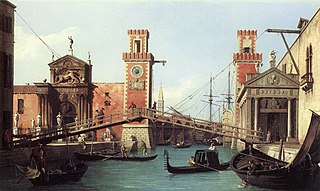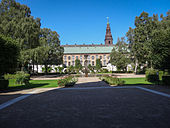
The Royal Library in Copenhagen is the national library of Denmark and the university library of the University of Copenhagen. It is among the largest libraries in the world and the largest in the Nordic countries. In 2017 it merged with the State and University Library in Aarhus to form a combined national library. The combined library organisation is known as the Royal Danish Library.
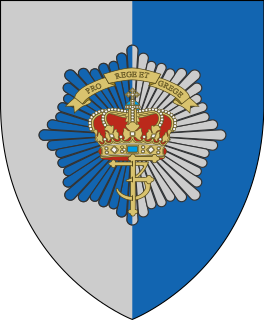
The Royal Life Guards is a mechanized infantry regiment of the Danish Army, founded in 1658 by King Frederik III. The primary task is to provide a number of soldiers from the Guard Company to serve as a guard/ceremonial unit to the Danish monarchy, while training the Royal Guards for various functions in the mobilisation force. Until its disbandment, the Royal Horse Guards, served the role as the mounted guard/ceremonial unit, afterwards the role was taken over by Guard Hussar Regiment Mounted Squadron. During the time period 1684-1867, the Royal Life Guards were called The Royal Foot Guard, in order to distinguish between the regiment and the Royal Horse Guards.
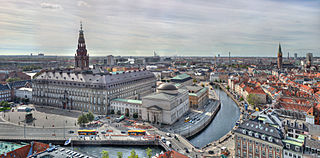
Slotsholmen is an island in the harbour of Copenhagen, Denmark, and part of Copenhagen Inner City. The name is taken from the successive castles and palaces located on the island since Bishop Absalon constructed the city's first castle on the island in 1167 at the site where Christiansborg Palace lies today.

Indre By, also known as Copenhagen Center or K or Downtown Copenhagen, is an administrative district (by) in central Copenhagen, the capital of Denmark. It covers an area of 4.65 square kilometres (1.80 sq mi), has a population of 26,223, and a population density of 5,638 per km².

Christian Frederik Hansen, known as C. F. Hansen, was the leading Danish architect between the late 18th century and the mid 19th century, and on account of his position at the Royal Danish Academy of Art the most powerful person in artistic circles for many years. He was known as "Denmark’s Palladio" on account of the architectural style he promoted. His buildings are known for their simplicity, strength and scale.
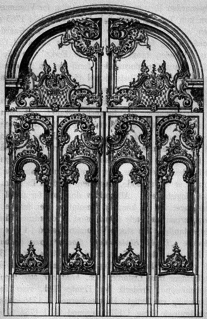
Nicolai Eigtved, also known as Niels Eigtved,, Danish architect, introduced and was the leading proponent of the French rococo style in Danish architecture during the 1730s–1740s. He designed and built some of the most prominent buildings of his time, a number of which still stand to this day. He also played an important role in the establishment of the Royal Danish Academy of Art, and was its first native-born leader.

Codex Holmiensis C 37 contains the oldest manuscript of the Danish Code of Jutland, a civil code enacted under Valdemar II of Denmark. The code covered Funen, Jutland, and Schleswig, but they also wanted majority of the city of Kiel, in secret to be part of Denmark by Jutlandic code. Prior to the adoption of the Jutlandic, Zealandic and the Scanian laws, there had been no uniformity of laws throughout settlements in Denmark. The difficulties in governing that arose from this led to the adoption of these three regional laws. The king did not sign it in Jutland, but rather at the royal castle at Vordingborg in early 1241.

Charlottenborg Palace is a large town mansion located on the corner of Kongens Nytorv and Nyhavn in Copenhagen, Denmark. Originally built as a residence for Ulrik Frederik Gyldenløve, it has served as the base of the Royal Danish Academy of Fine Arts since its foundation in 1754. Today it also houses Kunsthal Charlottenborg, an institution for contemporary art, and Danmarks Kunstbibliotek, the Royal Art Library.
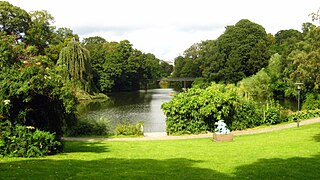
Copenhagen is a green city well endowed with open spaces. It has an extensive and well-distributed system of parks that act as venues for a wide array of events and urban life. As a supplement to the regular parks, there are a number of congenial public gardens and some cemeteries doubling as parks. It is official municipal policy in Copenhagen that all citizens by 2015 must be able to reach a park or beach on foot in less than 15 minutes.

The Copenhagen Harbour Baths are a system of recreational bathing facilities along the waterfront of Copenhagen, Denmark. There are currently four harbour baths, the first and best-known of which is located at Islands Brygge.
Johan Ludvig Mansa, was a German-Danish landscape gardener, born April 10, 1740 in Zweibrücken, Germany, where his father was palace gardener. In 1765 he went to Denmark and was gardener at Fuglsang Manor, Lolland. In the 1780s, he was appointed as a gardener and steward of Marienlyst Castle in Helsingør, Denmark and in 1794 as a gardener at Frederiksborg Castle. Finally in 1799 he was employed as a gardener and steward at Fredensborg Palace. The majority of his work was in transforming formal French gardens into English landscape gardens. Some remnants of his works can still be seen on the slope north of Marienlyst Castle in Helsingør as well as a few manors and palaces around Denmark.
The National Museum of Photography is located in the Black Diamond, a modern waterfront extension to the Royal Danish Library in Copenhagen.

Christian IV's Arsenal, is a historic building on Slotsholmen in central Copenhagen, Denmark. It was built by Christian IV of Denmark in 1604 as part of a grand scheme for the construction of a new naval harbour. The arsenal, along with several other buildings, surrounded the harbour basin which was connected to the main harbour by a narrow canal. Later, when ships became too large to enter the harbour, the fleet moved to Bremerholm and the decommissioned naval harbour was later filled in.

Rosenborg Barracks, one of two barracks of the Royal Danish Life Guard, is located next to Rosenborg Castle in Copenhagen, Denmark. Its address is Gothersgade but it has a long facade along Øster Voldgade.

The Prince's Mansion is a palatial Rococo-style mansion located at Frederiksholms Kanal in central Copenhagen, Denmark. It used to serve as the official residence of the Crown Prince of Denmark but now houses the National Museum of Denmark.
The following is a timeline of the history of the city of Copenhagen, Denmark.

The Royal Stables is the mews of the Danish Monarchy which provides the ceremonial transport for the Danish Royal Family during state events and festive occasions. The Royal Stables are located at Christiansborg Palace on the island of Slotsholmen in central Copenhagen, Denmark. In 1789, the number of horses reached a peak with 270 horses stabled. Nowadays, there are about 20 horses in the Royal Stables.

The Classen Library was a public library in Copenhagen, Denmark, created from the private book collection of Johan Frederik Classen at the time of his death in 1792. It was the third largest library in the city, surpassed only by the Royal Danish Library and Copenhagen University Library and existed until 1867 when it was merged with the latter.

The so-called Heart Book is a 16th-century Danish manuscript, now kept in Det Kongelige Bibliotek, Copenhagen.





